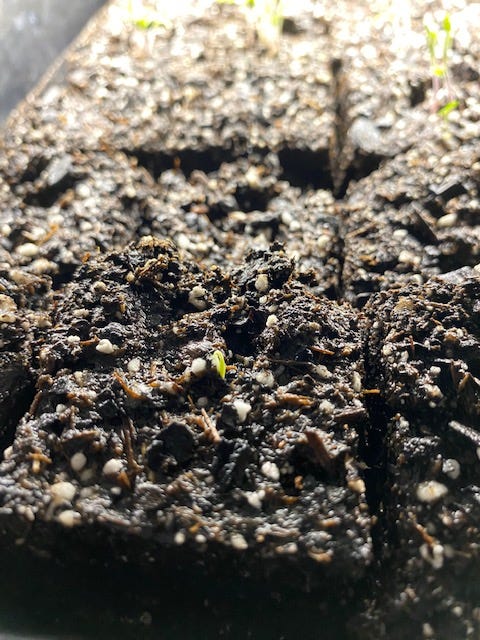What I’m seeing as I create new potato varieties
I love all things potatoes. This year I’m growing brand new, never-existed-before varieties.
We’re 4 weeks away from this blog’s first anniversary. My news this week is that I plan on offering seed potatoes from the new varieties I’m creating to a few random paid subscribers. Growing a potato plant from seed is a slower process (as I’m learning). Currently the plants grown from seed aren’t as mature as the plants grown from seed potatoes, so I anticipate the tubers the new plants produce will be smaller and later. I hope to save those seed potatoes and plant them in early 2025 to produce the first round of seed potato stock. Hopefully, this time next year I’ll surprise a few paid subscribers with seed potatoes that they can store and plant in 2026. I also have names picked out for the new varieties, but I’ll wait until I harvest the first potatoes before I share those monikers. Today’s post is primarily for paid subscribers. If you aren’t logged in or haven’t moved to a paid subscription, you’ll run into a paywall. I’m sharing several resources before that paywall to help make it easier for everyone to have information about creating their own potatoes.
In case you missed my first post in this potato journey, check out propagating potatoes from seed (not seed potatoes) for the background on how potato flowers produce seed pods. Last summer I collected those pods and carefully dried and preserved seeds from them. In February, when I started a round of seedling flats, I added 3-to-5 seeds per cell in a 9-cell corner of a tray. Not knowing what the germination rate would be—if any—I shot for the higher seed count for each cell.
I had, what appeared to be, a 100% germination rate. Happy potato seedlings shot up from all 9 cells. The hard thing I had to do: Thin them. If you’re new to starting seedlings, for some varieties of plants you need to snip or cull all but one seedling in each cell so that they’re not competing. (For tomatoes, you can generally skip that as they’re more resilient to separating.) In the creation of the 9 new varieties, I had to kill at least 27 other new varieties that never existed before, and now never will. (Potatoes are heterozygous, which means each seed in the seed pods they produce creates a completely different variety of potato that doesn’t match the parent plant or any other seed. This is also true for apples.)
According to the International Potato Center, more than 4,000 potato varieties exist today. The center also shares that, “Potatoes produce more food per unit of water than any other major crop and are up to 7 times more efficient in using water than [grains].” Considering the diversity and the water consumption benefits, a strategic way to maximize yields for a growing space would include incorporating potatoes of some kind.
Choosing a site to grow a new potato variety
Since I had 9 seedlings, I decided to choose a mix of test sites for them. Some I planted in my main in-ground garden within spaces that have previously had favorable production of a number of different plants. I sited a few seedlings near irrigation lines, and a few away from irrigation. The latter would primarily depend on our natural rainfall. Given that the seeds I had collected were from healthy plants that grew through a full season here, I felt confident that the seeded plants will be more well-adapted to our climate and typical rainfall. I also sited some seedlings in a high tunnel. Similarly, some near irrigation and some away.
The in-ground garden is exposed to stronger winds and direct impacts of rain, whereas the high tunnel is a semi-protected environment relying more on drip irrigation. Even though it’s covered, I intentionally overhead water the high tunnel at least once per week because I feel it’s important for water to reach every plant surface—just as they would if they got rained on.
Some other differences: The high tunnel plants don’t benefit from the minerals and soluble nitrogen in rainwater that the main garden receives. Beneficial and not-so-beneficial insect populations are also different between the two spaces, even though they’re just a few feet apart. Two examples: I see a higher density of whiteflies on brassicas in the high tunnel. I also see an incredibly dense population of orb-weaver spiders (also known as writing spiders), so much so that during the peak of summer I sometimes can’t walk through the tunnel without a long stick to remove the dozens of webs in the path, between tomato branches, and what feels like just about everywhere.
One thing I’m consistent about between the two spaces: I apply a foliar worm compost tea at least once per month, and a soil drench at the same cadence.



